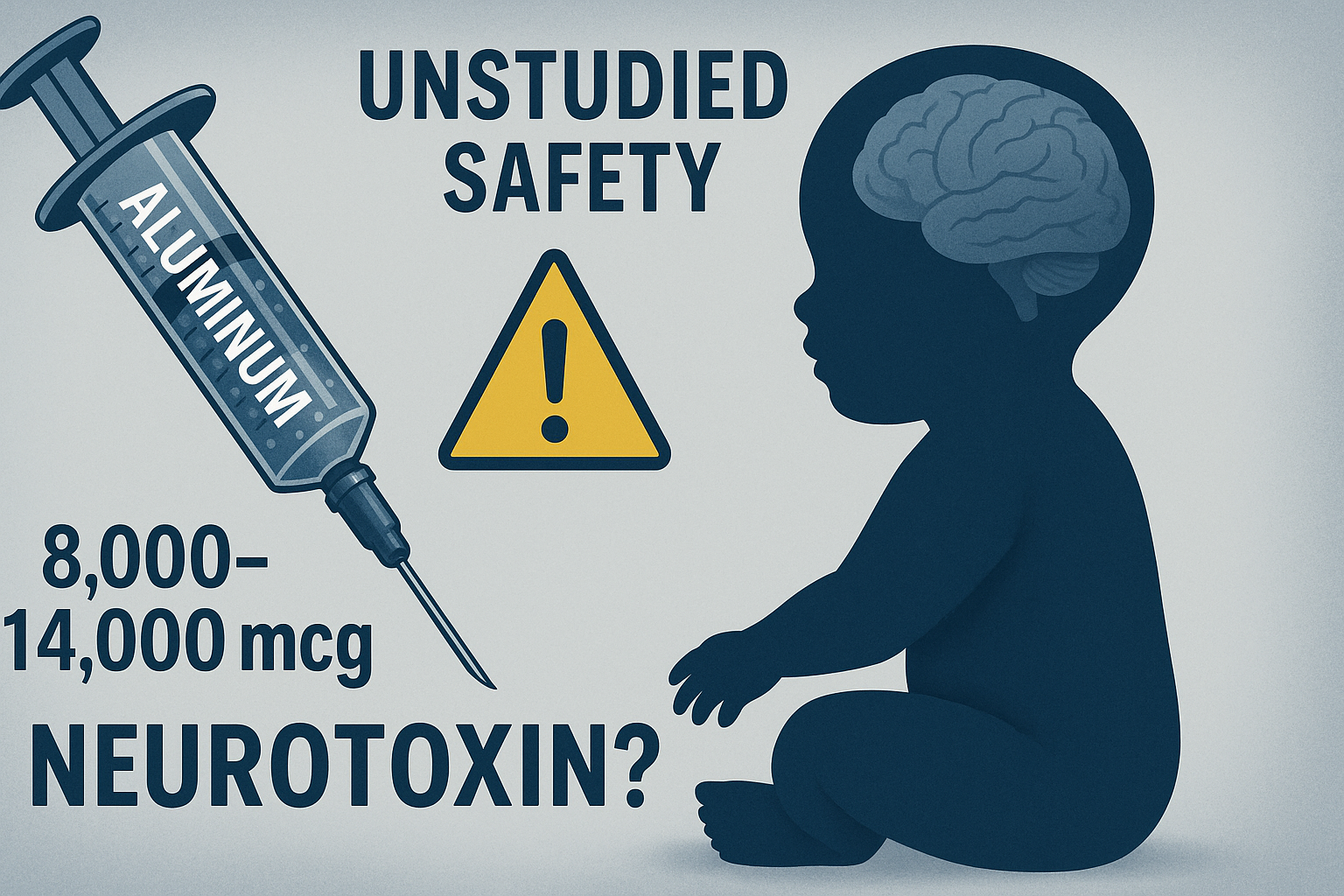
Health Freedom Defense Fund (HFDF) champions the rights of individuals to make informed decisions about their own health, and to do so free of coercion, and from threats to their livelihood or schooling. To exercise true informed consent, a person should have access not only to the claimed benefits of a drug or therapy, but to a comprehensive list of all ingredients in medicines and vaccines, with detailed information on the levels and safety of additives, preservatives, and adjuvants—and their risks
Unfortunately, informed consent has been largely dismantled in the context of vaccination, where the threat of expulsion from day care, school, activities, travel, or from employment is hanging over the head of the person deciding whether to take the injection. This decision can come as early as the first day of an infant's birth. In the United States, we require more vaccinations for our children than any country on earth, and this translates to the absorption and distribution throughout the body of more preservatives, additives, and adjuvants as well, all with varying levels of safety and toxicology study underpinning their use.
One adjuvant (activating agent) in vaccines that has repeatedly been associated with neurological disease, has undergone inadequate safety testing, and also serves a continuous, critical role in guaranteeing more low-quality data for future vaccine safety studies, is aluminum. HFDF calls for the urgent independent scientific inquiry into the impact of aluminum and its role not only as an adjuvant in childhood vaccine schedule, but as a dubious "placebo" ingredient for most safety studies for new vaccines.
Aluminum acts as an adjuvant in vaccines, by creating acute, local toxicity and cell death (causing the red dot at the injection site), and creating an immune reaction to drive a certain response against an antigen.[1] However, some cells take the aluminum into their cytoplasm and can move it around the body for extended periods.[2] It is this unpredictable process of retention and distribution that may cause more severe events and long-term damage. Unfortunately, as a regulatory matter, the levels of aluminum are optimized based on the antibody response being at a certain level, rather than concerns about safety. For safety, various health agencies around the world including the FDA establish a threshold maximum from a few very flawed studies (primarily Movsas 2013, Mitkus 2011, discussed below).
Aluminum is a known inflammatory neurotoxin and plays a role we are just beginning to understand in degenerative diseases of the brain, and is found in unusually high levels in the donated brains of people who suffered from Alzheimer's[3] and autism[4]. Aluminum is found in many foods and products (baby formula, processed foods, breast milk, etc) which provides constant low-level exposure but has a different mechanism of absorption and bio-availability via ingestion (usually chronic) vs intramuscular injection with vaccines (typically acute). The latter's distribution and retention in a baby's body has been studied only with extremely flawed methodology, small sample sizes, inapplicable study populations, questionable assumptions, and inappropriate tools, as we will discuss below. For reference one researcher estimated that, the amount of aluminum injected for a routine pneumococcal vaccine (Prevenar13) was roughly "equivalent to 260 days exposure to aluminum through breast feeding".[5] Some other products on the market, like antacids, also contain acute, very high levels of aluminum and are consumed via ingestion as well.
It is well established in the literature that while some aluminum is cleared through urine and sweat, an unpredictable amount of it accumulates in organs, tissues, and travels through the bloodstream and via macrophages to the brain, which causes microglia activation, which potentially raises immune system signals known as IL-6 cytokine levels, leading to neurological symptoms from injury and damage. The mechanism of macrophage transport is a relatively new discovery, but vaccine safety science has not adjusted its assumptions accordingly. Furthermore, aluminum poisoning can cause Macrophagic Myofasciitis (MMF) which is a continuous, persistent, aluminum-filled lesion. Aluminum poisoning results in dozens of symptoms associated with neurotoxic poisoning, from memory loss and confusion, to seizures, coma, and death. It causes kidney and bone diseases. It is found to be an endocrine disruptor[6], found in high levels in women with breast cancer in a Lancet study[7]. For this reason, there is an urgent need to ethically study and assess the potential and real-world impacts of these levels of aluminum in children's bodies as the result of vaccination, using independent high-quality research teams.
In the meantime, no more safety or comparison studies for future vaccines should be allowed to have the placebo injection include aluminum or other adjuvants and preservatives, as has historically been the case, as it obscures the true baseline rate of events, and masks any adverse events that may present as a result of these ingredients. Also in the meantime, practical advice for reducing aluminum exposure in general for infants is available in the peer reviewed literature.[i]
Unfortunately, there are financial and institutional pressures that preclude easy commissioning of safety studies of aluminum. Without the predictable inflammation and disease-specific antibody response arising from it, very few vaccines would be approved by regulatory authorities under the current adjuvant paradigm. This means the vaccine industry has to keep aluminum as the adjuvant until a replacement mechanism is found, and there is considerable pressure to ignore this problem. A disruption to the aluminum adjuvant mechanism would throw pharmaceutical companies, CDC, and FDA vaccine departments into disarray, but that should not override the need to do ethical testing and assessment of aluminum in the childhood schedule against a control group, which is very possible given the ample opportunities and volunteers for a true placebo.
Many will erroneously argue that it is unethical to withhold a vaccine from a population for a clinical trial like this. However, this ignores the fact that the primary unethical act in this scenario is injecting adjuvants like aluminum, without proper safety testing, into children while threatening to withhold schooling and other activities. It violates the standard of informed consent for medical treatment by any measure, as the safety information is unknown at this point, and the "consent" is only secured by way of threatening the subject.
What are the common responses by the medical establishment to these concerns about aluminum?
Despite the fact that CDC leadership famously noted in a paper in 2015 that “no large epidemiological studies have specifically examined associations between health outcomes” and aluminum in vaccines, the medical establishment and public health authorities still cite two papers from before that date to make most of their claims of safe levels of aluminum in the vaccination schedule.[ii]
FDA and CDC frequently cite a modeling study by Mitkus et al (2011) to claim that levels of aluminum in US vaccines are "safe" or "miniscule". However, the levels for "safe" amounts of aluminum typically come from this study of water-soluble aluminum lactate, not insoluble aluminum adjuvant particles delivered via injection. Obviously, as described above, there is a completely different biological mechanism of distribution, accumulation, and toxicity at play between adult rodents drinking water-soluble aluminum lactate, and an infant having aluminum particles injected intramuscularly, repeatedly and in batches.
And even in the Mitkus apples-to-oranges comparison, the level of exposure to ingested aluminum allegedly safe for adult animals, 26mcgs/kg/day, is broadly condemned in many peer reviewed studies as being far higher than mainstream science even claims.[8] Rats given only 3.4mcgs/kg/day showed behavioral, biochemical, and histological changes similar to those associated with Alzheimer’s disease.”[9] Even as low as 1.5mcg/kg/day there are side effects clearly present, notably even in animal studies with a stated purpose to “restore population confidence in Al-containing vaccines”. [10] Lastly, in this study, Mitkus looked at aluminum in the blood but not in tissues, and organs like the brain where it accumulates and does lasting damage. Nor should we forget that babies aren’t small adults with commensurate ability to process toxic exposure, so to apply the Mitkus study to babies is biologically inappropriate. Bizarrely, the modeling study assumes throughout that there is no lasting toxicity from aluminum nanoparticles that persist in the body after injection—a scientifically unfounded assertion.
The Movsas et al (2013) study observed just over a dozen pre-term infants for only a day and tested aluminum levels in blood serum after vaccination. It was limited by its small sample size (15 preterm infants only, developmentally distinct), short observation period (less than 24 hours), lack of a control group, measurement of only urine and blood serum (not tissues or organs), and failure to address cumulative exposures (multiple vaccinations, catch up appointments, etc). It also didn’t account for baseline aluminum from sources like pare-natal nutrition or the full CDC schedule (~40–50 mg aluminum salts through age 18). These limitations reduced Movsas et al.'s ability in the paper to fully assess the safety of aluminum adjuvants, especially for long-term tissue retention or broader populations.
Lastly, a recent Danish study by Andersson et al (2025) was touted in the media this year as a "definitive" answer that aluminum did not cause an increase in symptoms associated with autism, but the population received far fewer injections/aluminum than American counterparts (they removed thousands of Danish children who received the number of vaccines similar to the US schedule, or as they put it an "implausible number of vaccinations").[iii] The study also removed all children who received no vaccinations, so it looked at a tiny band of variation and one with no relevance to the American child's load of aluminum.
Shockingly, the study was so tilted in favor of proving safety, it went beyond showing no relationship and initially showed that more aluminum is beneficial in a child's body for many symptoms. Inexplicably, the authors looked for symptoms before children are diagnosed typically in Denmark (starting at ages 7-12). The authors assume a dosage-response linear relationship, that the more aluminum introduced, the more symptoms. While this could be true, peer reviewed studies have shown that even a small amount causes neurological harm which may not even be increased by more dosage.[11] The study quietly released an addendum of thousands more side effects that fully invalidated its findings (showed statistically significant rise in symptoms among those who took more aluminum—see Supplemental Figure 11). A full retraction of the paper is warranted.
A Call to Move Forward
Overall, there is considerable debate about the exact range of aluminum a child receives due to several forms of aluminum, aluminum salt, and variation in batches and labeling. Peer-reviewed studies have also highlighted huge variations, as high as 3x, the stated level of aluminum present, mislabeling of the exact types of aluminum, and limited evidence of government inspection to verify additive levels in vaccines.[12] However, it is fair to say that approximately 8,000 to 14,000 mcgs (8-14mgs) of aluminum or about 40mgs of aluminum salts (which help the elemental aluminum stay in one area) will be introduced into a child's body, if an infant/child receives all the current recommended vaccines throughout their young lives. Just as importantly, it is the acute nature of the early dosages (for example the 2-month visit requires seven vaccinations), and high levels particularly at "catch up" appointments, that necessitate an urgent investigation of the mechanism of potential acute aluminum toxicities over longer time periods. HFDF stands firm that adjuvants that are being injected into children should be studied rigorously and immediately, and that pressure and coercion have no place in medical decision making.
Given that the US is alone in the world in the sheer number of shots and therefore the amount of aluminum injected, it is unacceptable that there have been zero epidemiological studies of this known neurotoxin's effect on the population level, rigorously comparing neurological outcomes among children who don't take these vaccinations with those who do. Dozens of smaller studies at private practices, self-reporting surveys, and retrospective studies have shown clear indications of harm, indicating that larger studies are desperately needed. However, even when some population-level data exists, it is often discarded or hidden by public health authorities and their partners in industry. It is time for this situation to come to an end by leaning on cutting edge science to identify risks of adjuvants and ingredients before they are injected, and to hold the medical profession to its motto of "First, Do No Harm".
[1] https://www.sciencedirect.com/science/article/pii/S0946672X19304201#bib0005 (section 4)
[2] https://www.scopus.com/pages/publications/84907949395?inward=
[3] https://www.sciencedirect.com/science/article/pii/S0946672X16303777
[4] https://www.sciencedirect.com/science/article/pii/S0946672X17308763
[5] https://www.sciencedirect.com/science/article/pii/S0946672X19304201#bib0005
[6] https://pmc.ncbi.nlm.nih.gov/articles/PMC6108589/
[7] https://www.thelancet.com/article/S2352-3964(17)30233-5/fulltext
[8] Gherardi RK, Authier F. Macrophagic myofasciitis: characterization and pathophysiology. Lupus 2012;21(2):184-189. ____Authier FJ, Cherin P, Creange A, et al. Central nervous system disease in patients with macrophagic myofasciitis. Brain 2001;124(May, Pt 5):974- 983. ___Shaw CA, Li D, Tomljenovic L. Are there negative CNS impacts of aluminum adjuvants used in vaccines and immunotherapy? Immunotherapy 2014;6(10):1055-1071.
[9] https://pubmed.ncbi.nlm.nih.gov/26897372/
[10] https://www.sciencedirect.com/science/article/abs/pii/S0162013417303380?via%3Dihub
[11] https://www.sciencedirect.com/science/article/abs/pii/S0300483X16303043?via%3Dihub
[12] https://www.sciencedirect.com/science/article/pii/S0946672X21000523?via%3Dihub
[i] https://link.springer.com/article/10.1007/s12519-014-0477-x
[ii] https://www.sciencedirect.com/science/article/abs/pii/S0264410X15015054?via%3Dihub
[iii] https://www.acpjournals.org/doi/10.7326/ANNALS-25-00997














